South Korea Sensors Market Size
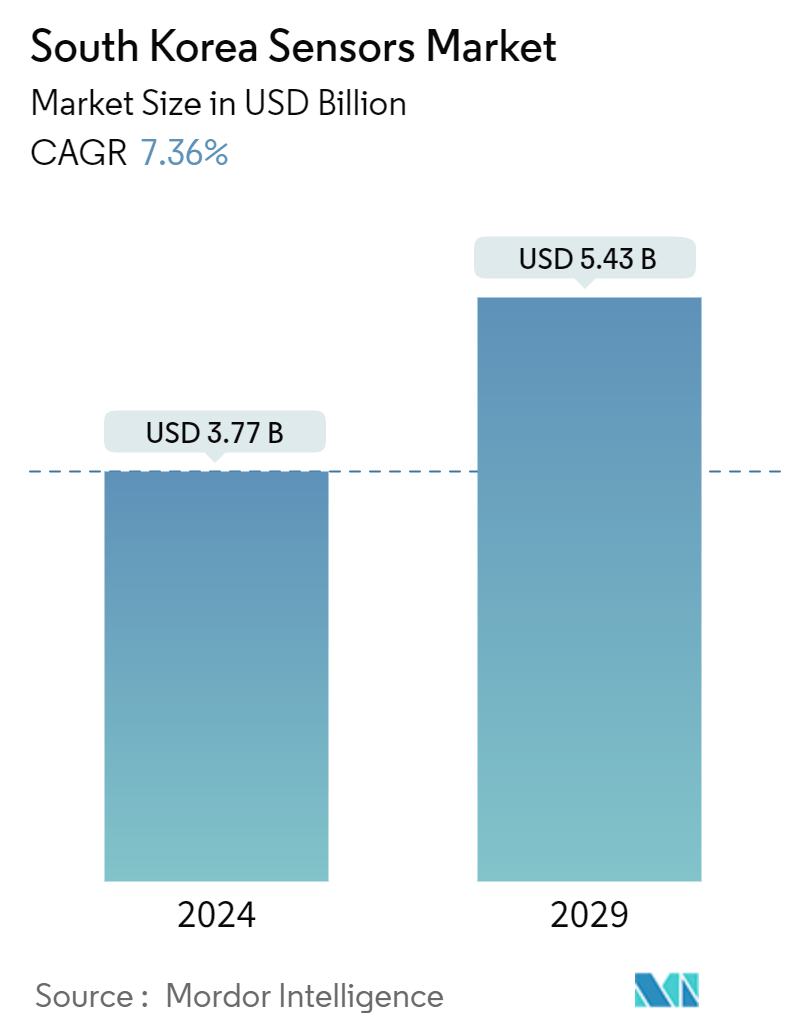
| Study Period | 2019 - 2029 |
| Base Year For Estimation | 2023 |
| Market Size (2024) | USD 3.77 Billion |
| Market Size (2029) | USD 5.43 Billion |
| CAGR (2024 - 2029) | 7.36 % |
| Market Concentration | Low |
Major Players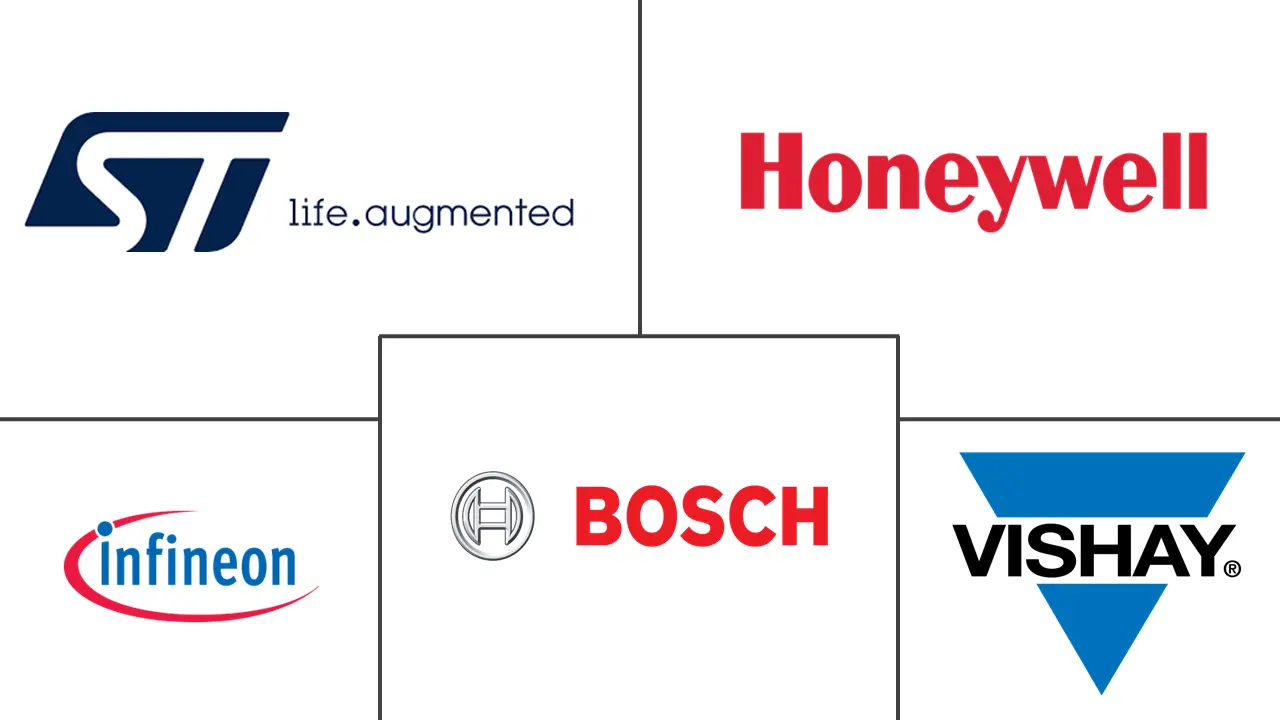
*Disclaimer: Major Players sorted in no particular order |
South Korea Sensors Market Analysis
The South Korea Sensors Market size is estimated at USD 3.77 billion in 2024, and is expected to reach USD 5.43 billion by 2029, growing at a CAGR of 7.36% during the forecast period (2024-2029).
- The surge in IoT technology has heightened the demand for sensors. Sensors are pivotal in collecting data from the physical world and enabling seamless communication among devices and systems. The growing importance of IoT in South Korea has resulted in a notable increase in the compatibility of sensors with IoT platforms, allowing for easier remote monitoring and control. This advancement in IoT-connected devices has created numerous opportunities for sensors in the industrial, medical, consumer electronics, automotive, and other sectors.
- The rise of automation in South Korea is expected to increase the need for sensors as they are essential in detecting, analyzing, measuring, and processing various changes, including shifts in position, length, height, surface, and movement in industrial manufacturing settings. Focusing on smart manufacturing, the Korean administration aims to set up 30,000 fully automated manufacturing firms by 2025. These firms will leverage advanced technologies like automation, data exchange, and IoT. Such initiatives are poised to significantly boost the demand for sensors in the country.
- The rise in sensor usage among smart device makers, coupled with a surge in the desire for superior image quality, is fueling the necessity for sensors across multiple sectors, including consumer electronics, automotive, defense, and healthcare. The increasing automation of manufacturing systems in discrete and process industries has also increased the need for components that deliver essential production process data. These sensors are crucial to improving factory process control by detecting the presence and position of metallic objects.
- The growth of various industries that utilize sensors has increased the demand in the country. In South Korea, there is a strong demand for sensors used in health applications, as there are ongoing concerns about the health of the population due to the increasing prevalence of chronic diseases. One of the key factors driving the necessity for sensors is the growing popularity of wearable health devices for monitoring patients.
- Market growth is expected to be hindered by the substantial costs of installing and maintaining smart sensors. The adoption of smart sensors has been slow, primarily because of the expensive components and batteries that drive the overall cost. Integrating sensors into existing systems can be challenging due to compatibility issues. The need for specialized knowledge is also impeding the market's growth. In addition, developing advanced sensor technologies often requires substantial research and development (R&D) investments, which can be a barrier for small companies.
- Macroeconomic factors like economic downturns can reduce business and consumer spending, leading to lower demand for sensor-equipped products and low investments in new technologies. Fluctuations in energy prices can influence the cost of production and transportation, impacting the overall cost structure for sensor manufacturers. In addition, tariffs, trade restrictions, and policies can impact the distribution and pricing of sensors, affecting the market dynamics.
South Korea Sensors Market Trends
The Environmental Sensors Segment is Expected to Witness Significant Growth
- Rapid technological advancements have significantly enhanced the accuracy and stability of environmental sensors. This progress has also ushered in a wave of new sensor types, including wireless, miniature, and intelligent variants. Such innovations promise extensive applications spanning real-time, remote, and intelligent monitoring scenarios.
- In November 2023, researchers at the Incheon National University pioneered advancements in gas sensing technology. The innovative method focuses on developing organic-inorganic hybrid gas sensors boasting exceptional durability, selectivity, and sensitivity.
- Researchers prioritize innovation in environmental sensors, which can be widely utilized in energy management, monitoring nitrogen dioxide in the atmosphere, and transportation, among other applications. In December 2023, the Korea Research Institute of Standards and Science (KRISS) engineered a toxic gas sensor boasting the world's most heightened sensitivity. This groundbreaking sensor excels at monitoring nitrogen dioxide (NO2), a hazardous atmospheric gas, even at room temperature. The sensors have remarkable precision, achieved with minimal power consumption and unparalleled sensitivity.
- With the growing climate change concerns, there is a heightened emphasis on monitoring environmental conditions. Environmental sensors are pivotal in gathering air and water quality data, temperature, and precipitation. Such data is indispensable for comprehending and tackling environmental hurdles.
- Seoul Metro aims to reduce pollution levels to 36% below legal thresholds by 2026, primarily through targeted subway pollution abatement strategies. This includes enhancements to the air circulation systems across tunnels, platforms, and concourses.
- Environmental sensors are crucial in helping cities and towns incorporate technology into their infrastructure and services. These sensors provide essential information that can improve energy efficiency and waste management, leading to overall sustainability. South Korea has been actively involved in the development of smart cities as a way to support the building of smart communities. These smart urban areas utilize technology and data to enhance sustainability and efficiency. With its robust digital infrastructure and widespread availability of technology, South Korea has established a crucial base for smart city projects.
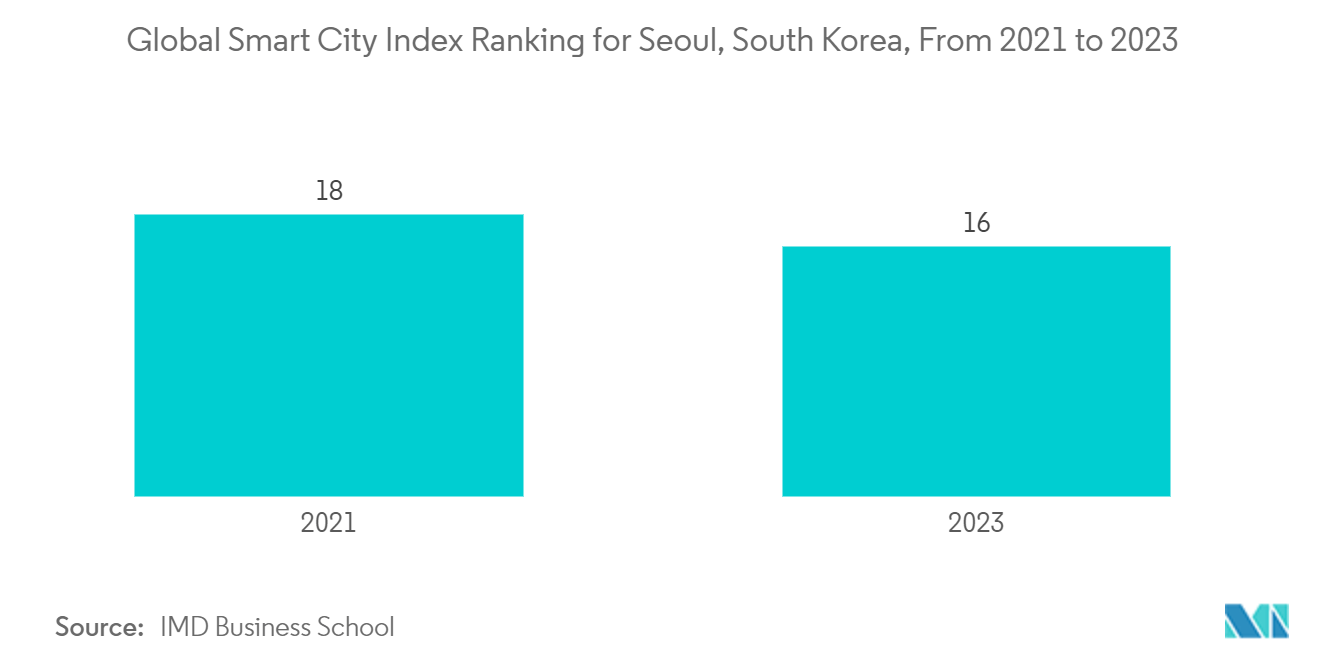
The Automotive Sector is Expected to Hold a Significant Market Share
- The automotive sector significantly boosts the demand for sensors in South Korea because of the diverse range of applications. The automotive industry's requirement for sensors is expected to grow substantially due to the increasing auto sales driven by the rising per capita income, the surge in electric vehicle adoption, and the growing vehicle autonomy. According to KAMA, South Korea produced approximately 4.24 million units of vehicles in 2023, marking a notable rise from the 3.76 million units in the preceding year.
- Moreover, as ADAS applications advance and become more intricate, effective methods will be required to communicate safety alerts and other relevant information to the driver. Head-up displays (HUDs) are an emerging solution that consolidates ADAS data onto a centralized screen, allowing the driver to maintain focus on the road while simultaneously receiving alerts and warnings on the windshield. Such advancements are spurring the demand for sensors in the market.
- South Korea's EV sector is thriving, propelled by the nation's genuine backing. The government offers a suite of incentives, including tax breaks, financial aid, and substantial R&D funding, to bolster the EV industry. Such initiatives attract investments and propel the sector toward the government's lofty EV adoption targets, driving the market's growth. To bolster EV production for exports, the government is leveraging tax incentives to entice car manufacturers to channel investments of up to KRW 95 trillion (USD 66.03 billion) into EVs by 2026.
- The increasing production and expansion of automotive plants in the country are expected to drive the demand for sensors during the forecast period. In November 2023, Hyundai Motor Co. began constructing a new EV (electric vehicle) manufacturing plant in Ulsan, South Korea. The project carries a total cost of KRW 2 trillion (approximately USD 1.5 billion). The plant, set to be finished in 2025, is planned with a production capacity of 200,000 units annually.
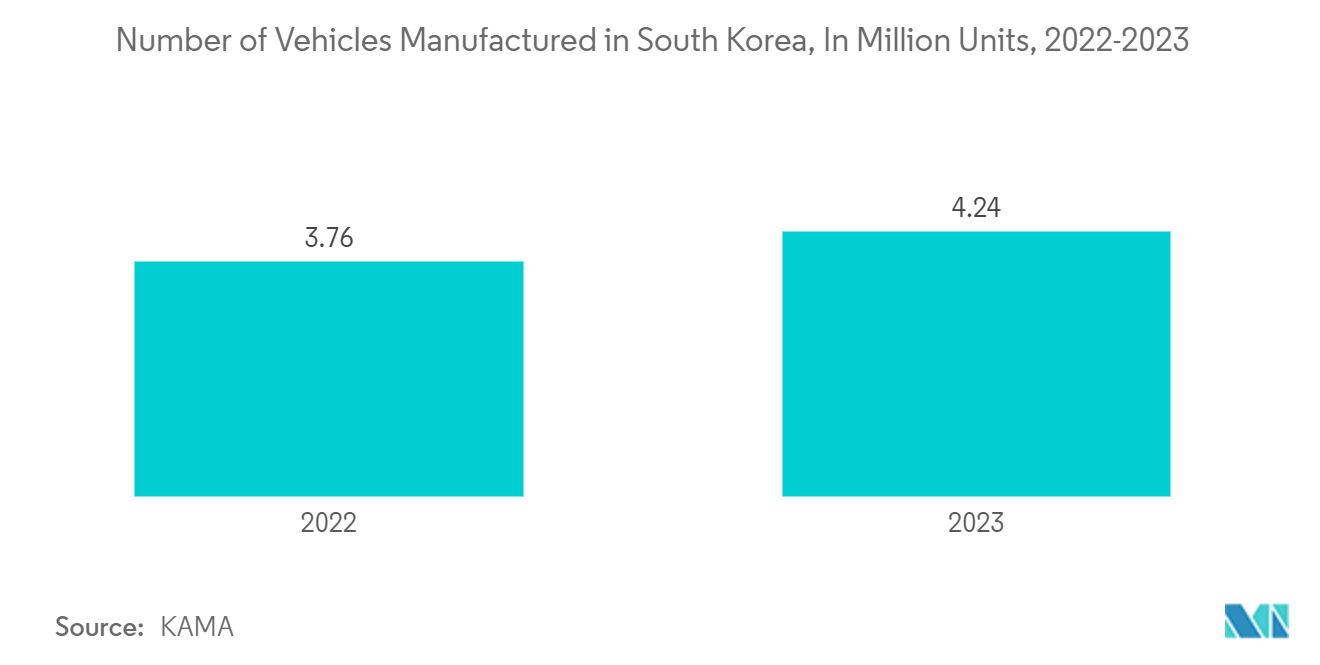
South Korea Sensors Industry Overview
The South Korean sensors market is fragmented, with the presence of major players like STMicroelectronics Inc., Honeywell International Inc., Infineon Technologies AG, Bosch Sensortec GmbH, Vishay Intertechnology Inc., TDK Corporation, and others. The players in the market are adopting strategies such as partnerships, mergers, innovations, investments, and acquisitions to enhance their product offerings and gain a sustainable competitive advantage.
- July 2024: Infineon Technologies AG and Swoboda partnered to introduce advanced current sensor modules designed for automotive use. This partnership leverages Infineon's high-quality current sensor ICs and Swoboda's prowess in sensor module development to tap into the burgeoning demand for sensing solutions in hybrid and electric vehicles. The inaugural product, Swoboda CSM510HP2, showcases a compact, fully encapsulated design, boasting a small footprint while maintaining top-notch performance.
- February 2024: Goodyear partnered with TDK Corporation, an electronics provider, to trial connected tire sensors, enhancing driver safety. These sensors, powered by TDK's piezoelectric material, can harvest energy and monitor crucial conditions like strain, speed, and impacts. The sensors analyze this data by employing edge AI, deciding when and how frequently to relay it to the car's onboard system or the driver. The system transmits data wirelessly using Bluetooth Low Energy (BLE), with the potential for testing other IoT technologies in the future.
South Korea Sensors Market Leaders
-
STMicroelectronics Inc.
-
Honeywell International Inc.
-
Infineon Technologies AG
-
Bosch Sensortec GmbH
-
Vishay Intertechnology Inc.
*Disclaimer: Major Players sorted in no particular order
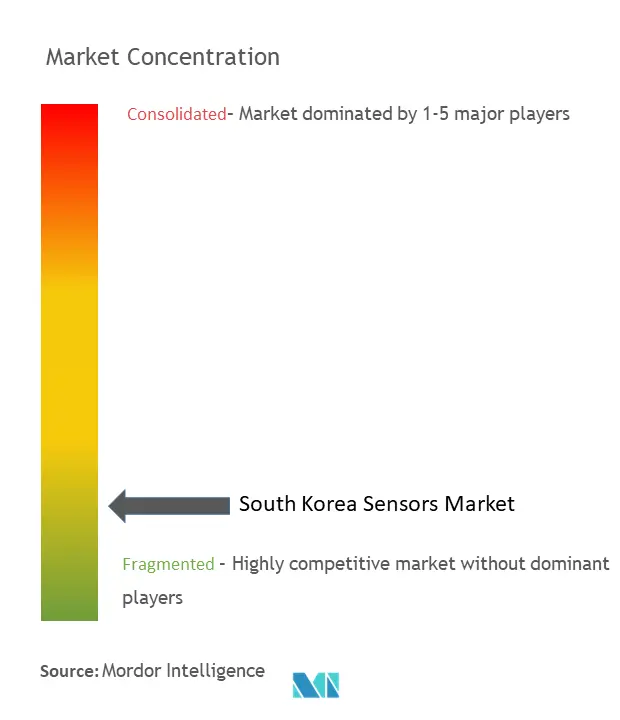
South Korea Sensors Market News
- July 2024: Allegro MicroSystems Inc. introduced its latest offerings, ACS37220, a high-power current sensor, and ACS37041, touted as the industry's most compact leaded magnetic current sensor. These innovations promise heightened efficiency, better system protection, and a streamlined bill of materials, outshining traditional solutions like discrete shunt resistors and op-amp-based current sensors. The ACS37220 is engineered as a substitute for high-power sense resistors, catering to high-current monitoring needs and supporting applications up to 200 A.
- January 2024: Infineon introduced the Xensiv TLI5590-A6W magnetic position sensor, using TMR technology to downsize position sensors for heightened precision in consumer and industrial applications. These sensors are designed to supplant optical and Hall encoders, boasting significantly enhanced linearity over prior magnetic sensor iterations. Infineon highlights that the device's high sensitivity, superior signal-to-noise ratio, minimal power consumption, and reduced jitter could pave the way for a fresh wave of affordable magnetic designs.
South Korea Sensors Market Report - Table of Contents
1. INTRODUCTION
- 1.1 Study Assumptions and Market Definition
- 1.2 Scope of the Study
2. RESEARCH METHODOLOGY
3. EXECUTIVE SUMMARY
4. MARKET INSIGHTS
- 4.1 Market Overview
-
4.2 Industry Attractiveness - Porter's Five Forces Analysis
- 4.2.1 Bargaining Power of Suppliers
- 4.2.2 Bargaining Power of Consumers
- 4.2.3 Threat of New Entrants
- 4.2.4 Threat of Substitute Products
- 4.2.5 Intensity of Competitive Rivalry
- 4.3 Industry Value Chain Analysis
- 4.4 Impact of COVID-19 and Other Macroeconomic Factors on the Market
5. MARKET DYNAMICS
-
5.1 Market Drivers
- 5.1.1 The Proliferation of IoT Devices in Various Industries, Including Industrial Automation
- 5.1.2 Growing Concerns About Environmental Issues and Regulatory Requirements
-
5.2 Market Challenges
- 5.2.1 High Initial Cost Involved
6. MARKET SEGMENTATION
-
6.1 By Product Type
- 6.1.1 Temperature
- 6.1.2 Pressure
- 6.1.3 Level
- 6.1.4 Flow
- 6.1.5 Proximity
- 6.1.6 Environmental (Humidity, Gas, and Combos)
- 6.1.7 Chemical
- 6.1.8 Inertial
- 6.1.9 Magnetic
- 6.1.9.1 Hall Effect Sensors
- 6.1.9.2 Other Magnetic Sensors
- 6.1.10 Position
- 6.1.11 Current
- 6.1.12 Other Types
-
6.2 By Mode of Operation
- 6.2.1 Optical
- 6.2.2 Electrical Resistance
- 6.2.3 Biosensor
- 6.2.4 Piezoresistive
- 6.2.5 Image
- 6.2.6 Capacitive
- 6.2.7 Piezoelectric
- 6.2.8 LiDAR
- 6.2.9 Radar
- 6.2.10 Other Modes of Operation
-
6.3 By End-user Industry
- 6.3.1 Automotive
- 6.3.2 Consumer Electronics
- 6.3.3 Energy
- 6.3.4 Industrial and Others
- 6.3.5 Medical and Wellness
- 6.3.6 Construction, Agriculture, and Mining
- 6.3.7 Aerospace
- 6.3.8 Robotics
7. COMPETITIVE LANDSCAPE
-
7.1 Company Profiles*
- 7.1.1 STMicroelectronics Inc.
- 7.1.2 Honeywell International Inc.
- 7.1.3 Infineon Technologies AG
- 7.1.4 Bosch Sensortec GmbH
- 7.1.5 Vishay Intertechnology Inc.
- 7.1.6 TDK Corporation
- 7.1.7 Texas Instruments Incorporated
- 7.1.8 ABB Limited
- 7.1.9 Siemens AG
- 7.1.10 ams OSRAM AG
- 7.1.11 Allegro MicroSystems Inc.
- 7.1.12 Omega Engineering Inc.
8. INVESTMENT ANALYSIS
9. FUTURE OF THE MARKET
** Subject To AvailablitySouth Korea Sensors Industry Segmentation
A sensor is designed to detect and react to various inputs from the physical environment, including pressure, heat, light, motion, and moisture. Typically, a sensor's output is a signal. This signal can be displayed in a human-readable format at the sensor's location or transmitted electronically over a network for convenient reading or further processing. Sensor technology is continually advancing, enhancing accuracy and repeatability in measurements. This evolution underscores the dynamic nature of sensor-based technology.
The study tracks the revenues accrued through the sale of sensors by various market players in South Korea. The study also tracks the key market parameters, underlying growth influencers, and major vendors operating in the industry, which supports the market estimations and growth rates over the forecast period. The study further analyses the overall impact of COVID-19 and other macroeconomic factors on the market. The report's scope encompasses market sizing and forecasts for the various market segments.
The South Korean sensors market is segmented by product type (temperature, pressure, level, flow, proximity, environmental (humidity, gas, and combos), chemical, inertial, magnetic (Hall effect sensors and other magnetic sensors), position, current, and other types), mode of operation (optical, electrical resistance, biosensor, piezoresistive, image, capacitive, piezoelectric, LiDAR, radar, and other modes of operation), and end-user industry (automotive, consumer electronics, energy, industrial and others, medical and wellness, construction, agriculture and mining, aerospace, and robotics). The market sizes and forecasts are provided in terms of value (USD) for all the above segments.
| By Product Type | Temperature | |
| Pressure | ||
| Level | ||
| Flow | ||
| Proximity | ||
| Environmental (Humidity, Gas, and Combos) | ||
| Chemical | ||
| Inertial | ||
| Magnetic | Hall Effect Sensors | |
| Other Magnetic Sensors | ||
| Position | ||
| Current | ||
| Other Types | ||
| By Mode of Operation | Optical | |
| Electrical Resistance | ||
| Biosensor | ||
| Piezoresistive | ||
| Image | ||
| Capacitive | ||
| Piezoelectric | ||
| LiDAR | ||
| Radar | ||
| Other Modes of Operation | ||
| By End-user Industry | Automotive | |
| Consumer Electronics | ||
| Energy | ||
| Industrial and Others | ||
| Medical and Wellness | ||
| Construction, Agriculture, and Mining | ||
| Aerospace | ||
| Robotics |
South Korea Sensors Market Research FAQs
How big is the South Korea Sensors Market?
The South Korea Sensors Market size is expected to reach USD 3.77 billion in 2024 and grow at a CAGR of 7.36% to reach USD 5.43 billion by 2029.
What is the current South Korea Sensors Market size?
In 2024, the South Korea Sensors Market size is expected to reach USD 3.77 billion.
Who are the key players in South Korea Sensors Market?
STMicroelectronics Inc., Honeywell International Inc., Infineon Technologies AG, Bosch Sensortec GmbH and Vishay Intertechnology Inc. are the major companies operating in the South Korea Sensors Market.
What years does this South Korea Sensors Market cover, and what was the market size in 2023?
In 2023, the South Korea Sensors Market size was estimated at USD 3.49 billion. The report covers the South Korea Sensors Market historical market size for years: 2019, 2020, 2021, 2022 and 2023. The report also forecasts the South Korea Sensors Market size for years: 2024, 2025, 2026, 2027, 2028 and 2029.
South Korea Sensors Industry Report
Statistics for the 2024 South Korea Sensors market share, size and revenue growth rate, created by Mordor Intelligence™ Industry Reports. South Korea Sensors analysis includes a market forecast outlook for 2024 to 2029 and historical overview. Get a sample of this industry analysis as a free report PDF download.



